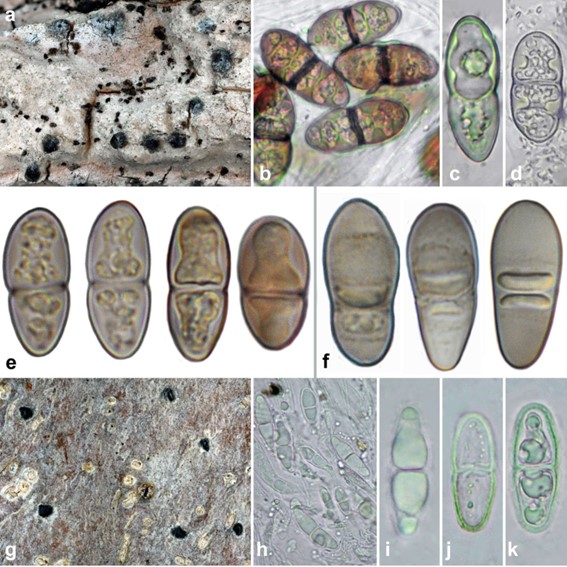Bogoriella complexoluminata Aptroot & Lücking sp. nov.(Fig. 79a–d)
MycoBank number: MB 836786; Index Fungorum number: IF 836786; Facesoffungi number: FoF 08792
Etymology: Named for the complex lumina of the ascospores.
Diagnosis: Corticolous Bogoriella with thallus UV-negative; ostioles apical, ascospores 27–37 × 10–15 µm, initially hyaline and 1-septate with an euseptum, constricted at the septum, wall thickened in two open distosepta two places in each cell, so as to from three pseudoloculiper cell; mature ascospores brown with 1 dark brown median euseptum and a distoseptate wall that leaves six rows of 2–6 oval loculi of c. 5 µm diam.
Holotype: A. Aptroot 78050 (CGMS; isotype: ABL).
GenBank accessions for type-based sequences: mtSSU: MT968880.
Thallus inapparent, immersed in the soft, corky bark, covering up to 10 cm diam., apparently not lichenized; no algae observed. Ascomata erumpent to sessile, hemisphaerical with flattened top, black, 0.3–0.5 mm diam. and up to 0.4 mm high; ostiole black, minute, usually in a c. 0.1 mm wide and 0.05 mm deep depression; clypeus covering the top and the sides; wall c. 100 µm thick at the sides, only c. 20 µm thick below the hamathecium. Hamathecium clear, hyaline, of c. 1 µm wide filaments that are anastomosing above the asci. Asci broadly cylindrical, c. 100 × 25 µm, wall c. 2 µm thick all around; without ocular chamber. Ascospores 8/ascus, 27–37 × 10–15 µm, initially hyaline and 1-septate with an euseptum, constricted at the septum, wall thickened in two open distosepta two places in each cell, so as to form three pseudoloculi per cell; mature ascospores brown with 1 dark brown median euseptum and a distoseptate wall that leaves six rows of 2–6 oval loculi of c. 5 µm diam. Pycnidia not observed.
Chemistry: Thallus UV–, C–, P–, K–. TLC: nil.
Ecology and distribution: On tree bark in rural and urban areas; thus far only known from Brazil.
Material examined: Brazil. Mato Grosso do Sul, Campo Grande, UFMS campus; 20°30’ S, 54°37’ W, 550 m; on soft, corky bark of Aspidosperma tomentosa (Apocynaceae) tree (identified by Dr Angela Sartori); 22 November 2018, A. Aptroot 78050 (holotype: CGMS; isotype: ABL); Bonito, outskirts, near tower; 21°07′44″ S, 56°30′41″ W, 475 m; on bark of tree; 9 November 2018, A. Aptroot 78013 (paratype: CGMS).
Notes: This new species is phylogenetically closely related to the type species, Bogoriella decipiens, but the latter differs in having regularly muriform ascospores. The endospore development of B. complexoluminata appears to be unique, producing a peculiar shape of the lumina.

Fig. 79 a–d Bogoriella complexoluminata (holotype). a Thallus with ascomata. b–d Ascospores in various stages of development. e B. isthmospora (Aptroot s.n.), ascospores in various stages of development. f Schummia angulata (Aptroot 14061), ascospores in various stages of development. g–k Macroconstrictolumina megalateralis(holotype). g Thallus with ascomata. h Hamathecium and ascospores. i–k Ascospores in various stages of development. Scale bars: a, g = 1 mm, b–f, h–k = 10 µm. Photographs by André Aptroot except e and f, by Felix Schumm
Species
